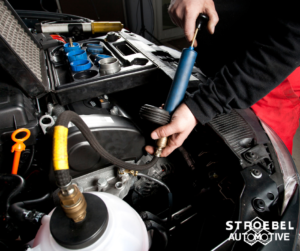August is here, and we all know what that means: higher temperatures, higher humidity, and more chance for your engine to overheat. But that doesn’t mean you can’t prepare now and ensure your cooling system is ready.
An engine cooling system has four main parts: the radiator, hoses, belt, and pump. All these components work together to keep your car running smoothly in even the hottest weather conditions.
- Check your radiator’s coolant level and ensure it’s not low or contaminated with dirt or rust particles. You can add distilled water until it reaches the top of the radiator neck (about 1 inch below where it comes out of a hose). If this doesn’t solve an overheating problem, consider replacing your thermostat. If it hasn’t been replaced in over five years, it may be stuck open or closed due to corrosion inside its housing.
- Check all hoses for cracks, leaks, and bulges caused by worn-out rubber seals around them. Replace any leaking hose immediately because a small leak will quickly become a major one if left unattended. Check belts for wear and tear — they should be replaced every 30K miles or three years depending on conditions such as hot weather where belts tend to wear faster than normal due to increased engine temperature during operation.
If any of these components breaks down or fails due to wear and tear over time (or even just because it’s old), you could experience overheating problems during hot weather months like August and September–so keep an eye out for warning signs!
Check the coolant level.
You should check the coolant level once a month. This is especially important on older vehicles, as well as those that have been in storage for an extended period of time.
When you check it, make sure to do so with your engine cold and off. If you can’t remember how long it’s been since you last checked, go ahead and do it–you won’t hurt anything by checking too often!
Check the radiator cap for cracks or leaks.
Check the radiator cap for cracks or leaks. If you find a crack, replace it immediately. If you find a leak, replace it immediately. The radiator cap acts like a pressure relief valve; over time, it can lose its ability to keep a secure seal when tightened.
Inspect hoses and belts for signs of wear and tear.
The belts and hoses are especially vulnerable to damage from age, so be sure to check them for cracks or soft spots. You should also look for signs of wear on the pulleys and fan blades. If they’re worn down too much, they could break unexpectedly–and that could mean complete failure of your entire cooling system. The belt is the most common cause of overheating. The belt connects the water pump to the engine, and it keeps the water pump spinning properly so it can move liquid through your car’s pipes and hoses as needed.
Replace an old water pump if it’s starting to leak.
If you see coolant leaking from your vehicle, it’s time to get it checked out by a mechanic. Overheating can cause major damage to your engine and other car parts–including the water pump itself. A leaky water pump can also lead to overheating in the long run, so even if you don’t notice any problems right away, replacing an old one could save you from bigger headaches down the road.
The water pump is what forces coolant through the rest of your vehicle’s engine and then back into the cooler tank when necessary to maintain proper temperature levels inside it at all times.
Remember, when you’re driving, friction between your car’s moving parts causes heat–and if there isn’t enough room for that heat to escape through vents or other openings in your engine bay, then things will get too hot very quickly.


